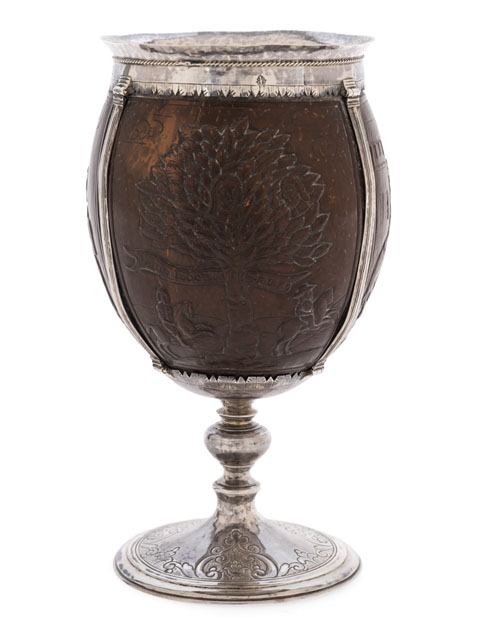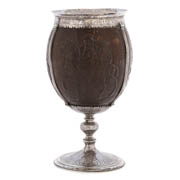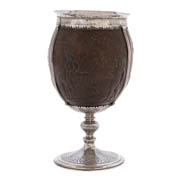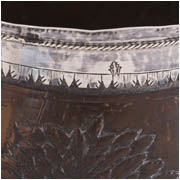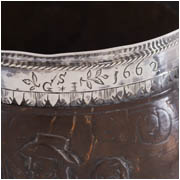Details
- Object type
coconut cup
- Place Associated
England
- Date
1625-1675
- Materials
coconut, silver
- Dimensions
overall: 189 mm x 95 mm x 93 mm 261 g
- Description
-
Coconuts were imported to Britain from India as early as the 8th century, and then, by the sixteenth century, imported from South America and the West Indies. They were considered a highly exotic material, prized for their restorative powers; drinking from a coconut was said to heal ailments and protect the drinker from poison. Some were mounted in silver, transformed into bowls and cups. This coconut cup has silver mounts, rim, and foot. The rim is engraved with ‘G//S//I’ and ‘1662’, maker’s mark: ‘I W’ monogram (I over W with three mullets).
By the seventeenth century, the coconut cup was primarily for display as a ‘curiousity’. The value of the cup was increased if they were carved with scenes of religion, mythology, or commemorative events. The coconut of this cup is divided into three sections by silver bands; each section engraved with a scene of the escape of Charles II (1630-1685) after his defeat at the Battle of Worchester on 3 September 1651. After the battle, Charles fled from Parliamentarian forces and for six weeks travelled in disguise, and kept safe in the houses of loyal Royalists. On the 15th October, he sailed to France were he remained in exile for 9 years. Charles was restored to the throne of England in 1660 leading to a spark of royal memorabilia celebrating his return. Scenes and stories from the dramatic escape of 1651, as seen on this coconut cup, were a much used decorative motif and popular propaganda story to celebrate the Restoration of the monarchy.
In the first of the three carved coconut sections, there is a large leafy oak tree with the face of Charles II in the centre of the leaves. Below the tree, two men on horseback, representing Parliamentary forces, ride past. On 6th September 1651, Charles and his servant, Colonel William Careless, arrived at Boscobel House as part of their escape. In order to hide from Parliamentary forces searching the surrounding woodlands, Charles and William hid in a nearby oak tree. This episode of the escape, known as ‘the Royal Oak’, was commemorated in dramatic plays, written accounts, and prints of the time; the image here probably taken from a print similar to one published by Peter Stent found in the Royal Collections Trust (RCIN 602671).
The second carved section shows Charles dressed in the disguise of servants clothing, riding a horse. To the right, a man dressed in labourer’s clothes stands with a horse whip in hand, probably representing Humphrey Penderel, a mill worker, who accompanied Charles from Boscobel House to Mosely Old Hall on 7th September. Penderel gave Charles the horse from his mill to ride on their journey. The horse, however, was old, making Charles exclaim that it was 'the heaviest dull jade he ever rode on'. In popular retellings of the story, Penderel replied that this was to be expected for the horse ‘has the weight of three kingdoms on his back' (referencing Charles’ rule as king of England, Scotland, and Ireland). In the carving on the coconut cup, the horse is shown feeling this strain, struggling under the weight of Charles, the back legs bucking, and its head bowed.
In the third section, Charles is shown riding a horse with a woman sitting behind. The woman is most probably Lady Jane Lane of Bentley Hall where Charles stayed on 9th September 1651. Jane Lane had received permission to visit a friend near Bristol. As Bristol was a seaport, it offered Charles the chance to board a ship to France. Charles dressed in disguise as Jane Lane’s servant and accompanied her on the journey, riding on the same horse. After Charles was restored to the throne in 1660, he rewarded Jane Lane with a pension of £1000 a year.
Provenance: W.B. Redfern, Esq. collection (sold at Sotheby’s, London, 20-21 June 1934, lot.294); David Black, from whom purchased by Sir William more
- Credit Line/Donor
Gifted by Sir William and Lady Burrell to the City of Glasgow, 1944
- Collection
Burrell Collection: Silverware
- ID Number
43.21
- Location
Burrell Collection Central Galleries
